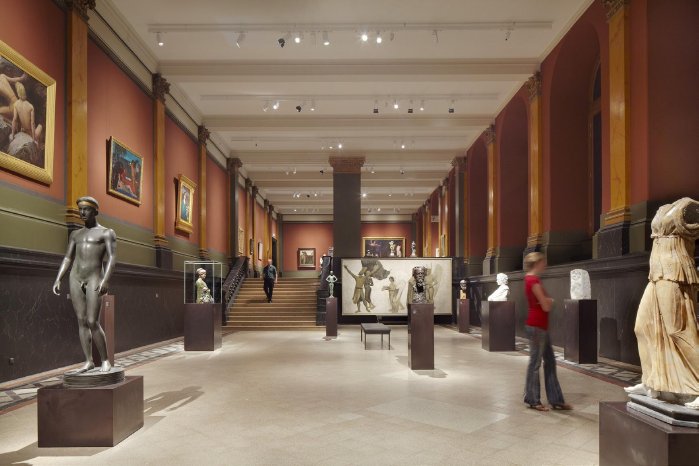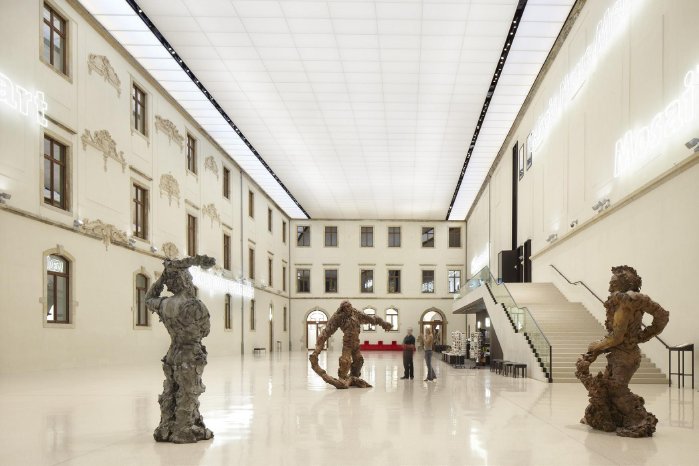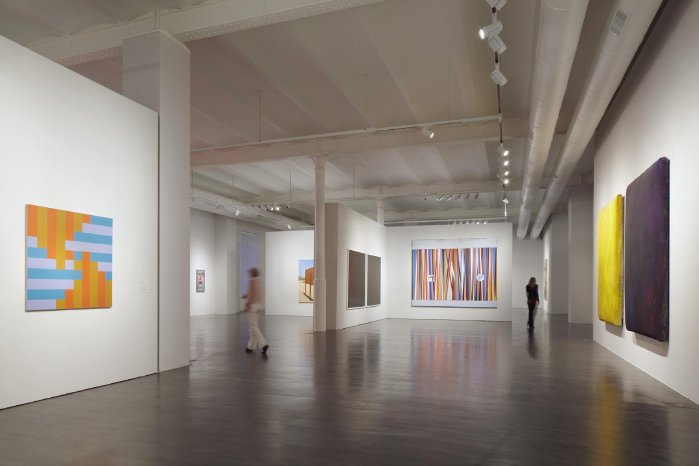The lighting concept was developed by Lichtvision GmbH in collaboration with Zumtobel. Lighting designer Karsten Ehling confirms that valuable exhibits need to be treated with special care, and adds: "Lighting design involves more than just a beautiful idea. The concept has to be technically feasible; building maintenance is an important aspect. In museums in particular, conservational aspects must be taken into account as well, i.e. the quantity of light acceptable for an old painting, for instance." Precisely these aspects have been taken into account by the lighting designers and electrical consultants when they implemented the building-wide lighting solution.
From the museum lobby, visitors directly enter the sculpture hall where delicate works of art are on display. The newly designed inner courtyard is situated directly next to this hall. Staab architects have converted this previoulsy unused area into an impressive atrium topped off by a two-storey depot. Like a huge bridge without any supports to rest on, the 70 metres long, 25 metres wide and 10 metres high depot spans the 1700 square metre inner court yard. In this way, the architects around Volker Staab have created a sophisticated "ark for art". "On the underside of the depot, we have fitted a semitransparent spanned ceiling visually creating the effect of a dimmed luminous ceiling", explains Volker Staab. In reality, filtered daylight only enters the yard through the outer ceiling sheets. Zumtobel light ribbons have also been installed there, which can be additionally switched on via a lighting control system, if required. Incident daylight is monitored by an external daylight sensor installed on the roof of the Albertinum. Whenever daylight is not sufficient to provide the illuminance level required, the Tecton continuous row systems are also switched on via the Luxmate Professional lighting management system. This ensures that whenever the weather is bad, or when it gets dark early in winter, for instance, the atrium keeps its attraction and a mystic lighting stage is set in the newly created room. In addition, Arcos spotlights have been installed in two 3-phase tracks extending along the entire length of the ceiling sheets. Each spotlight can be individually addressed and controlled via the Luxmate lighting control system, by means of DALI control. Focussed accent lighting is mainly used for special events. In this way, the huge area can be illuminated by multifacetted light - ranging from uniform ambient lighting through to lighting cones in a variety of shades.
A tour of the first floor provides visitors with insights into art from antiquity up to the present. The whole floor has been uniformly fitted with Arcos spotlights by Zumtobel. These DALI-controlled spotlights have been installed on Tecton trunking and can be positioned perfectly. "The spotlights simply allow for maximum flexibility when rearranging or removing paintings. As the spotlights can be individually aligned and controlled, we have unlimited freedom in terms of creative power", explains Michael John, chief engineer. The 11-pole trunking unit is also used for the purpose of advanced LED emergency lighting: owing to its high efficiency and ideal light distribution, few compact Resclite LED luminaires are sufficient to safely illuminate the exhibition areas in an emergency. Built into the Tecton trunking, they are barely visible. With a minimum installed load of 5 watts and a service life of 50,000 hours, they help the museum save ready cash.
While trendy, calm white tones prevail in the contemporary art areas, the Klingersaal, which is protected as a monument, still shows features of the former interior design. Pillars with delicate decoration, walls painted in mystic ruby colour, and elaborately brushed trims take visitors back to the time when the paintings and sculptures on display originated. As no major structural alterations had been permitted due to reasons of preservation, this is the only room without an air-conditioning system. Yet it was possible to adjust the lighting system. Here, too, Arcos spotlights demonstrate their flexibility. Despite the very high ceiling, the exhibits are presented to optimum effect by focussed lighting; even subtle shades and material qualities are adequately highlighted. In order to provide wide-area illumination of the walls, special wallwasher attachments have been used which include a special lens and a floodlight reflector module. In turn, anti-glare blades were installed in other places in order to effectively and flexibly reduce scattered light around the exhibits illuminated. The QT 12 light sources used already include IR and UV filters. These consistently ensure lighting that meets conservational requirements throughout the museum.
On the second floor, the rooms look markedly different. The paintings mainly on display in this area date back to 1945 and up to the present day. Artists such as C.D. Friedrich, Gerhard Richter or Georg Baselitz are represented in different sections. While the first floor features three large exhibition areas along the linear axes and only two display depots at the ends, the second floor is made up of numerous small sections. Walking through the exhibition, visitors experience an exciting journey through art history. Other than in the previous museum areas, the lighting concept here uses an indirectly backlit louvre ceiling. This creates an impression of daylight entering the room through the ceiling. Moreover, the calm ceiling makes the rooms appear larger, giving the paintings plenty of scope to unfold their aesthetic effect.
Eventually, during refurbishment, not only every-day aspects were taken into account. In extraordinary situations, too, the lighting must ensure safety and orientation. Besides the LED emergency luminaires installed, escape sign luminaires are also available for emergencies. In every-day situations, these extremely flat luminaires stay unobtrusively in the background. They boast an aluminium frame only 3 mm thick, a shallow surface-mounting height, and a recognition range of 30 metres thanks to advanced LED technology. This makes sure that visitors can enjoy their time at the museum feeling calm and safe.





